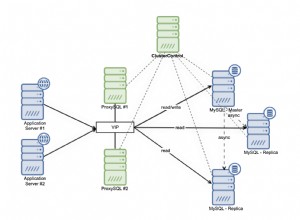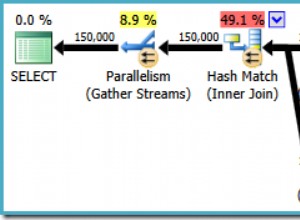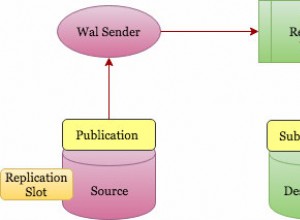MySQL 8.0 ora supporta le funzioni di windowing, come quasi tutte le popolari implementazioni SQL. Con questa sintassi standard, possiamo scrivere le più grandi n query per gruppo:
WITH ranked_messages AS (
SELECT m.*, ROW_NUMBER() OVER (PARTITION BY name ORDER BY id DESC) AS rn
FROM messages AS m
)
SELECT * FROM ranked_messages WHERE rn = 1;
Di seguito è riportata la risposta originale che ho scritto per questa domanda nel 2009:
Scrivo la soluzione in questo modo:
SELECT m1.*
FROM messages m1 LEFT JOIN messages m2
ON (m1.name = m2.name AND m1.id < m2.id)
WHERE m2.id IS NULL;
Per quanto riguarda le prestazioni, una soluzione o l'altra possono essere migliori, a seconda della natura dei tuoi dati. Quindi dovresti testare entrambe le query e utilizzare quella che ha prestazioni migliori in base al tuo database.
Ad esempio, ho una copia del Dump di dati StackOverflow di agosto
. Lo userò per il benchmarking. Ci sono 1.114.357 righe nei Posts tavolo. Questo è in esecuzione su MySQL
5.0.75 sul mio Macbook Pro 2.40GHz.
Scriverò una query per trovare il post più recente per un determinato ID utente (il mio).
Prima utilizzo della tecnica mostrato
di @Eric con il GROUP BY in una sottoquery:
SELECT p1.postid
FROM Posts p1
INNER JOIN (SELECT pi.owneruserid, MAX(pi.postid) AS maxpostid
FROM Posts pi GROUP BY pi.owneruserid) p2
ON (p1.postid = p2.maxpostid)
WHERE p1.owneruserid = 20860;
1 row in set (1 min 17.89 sec)
Anche il EXPLAIN analisi
impiega più di 16 secondi:
+----+-------------+------------+--------+----------------------------+-------------+---------+--------------+---------+-------------+
| id | select_type | table | type | possible_keys | key | key_len | ref | rows | Extra |
+----+-------------+------------+--------+----------------------------+-------------+---------+--------------+---------+-------------+
| 1 | PRIMARY | <derived2> | ALL | NULL | NULL | NULL | NULL | 76756 | |
| 1 | PRIMARY | p1 | eq_ref | PRIMARY,PostId,OwnerUserId | PRIMARY | 8 | p2.maxpostid | 1 | Using where |
| 2 | DERIVED | pi | index | NULL | OwnerUserId | 8 | NULL | 1151268 | Using index |
+----+-------------+------------+--------+----------------------------+-------------+---------+--------------+---------+-------------+
3 rows in set (16.09 sec)
Ora produce lo stesso risultato della query utilizzando la mia tecnica
con LEFT JOIN :
SELECT p1.postid
FROM Posts p1 LEFT JOIN posts p2
ON (p1.owneruserid = p2.owneruserid AND p1.postid < p2.postid)
WHERE p2.postid IS NULL AND p1.owneruserid = 20860;
1 row in set (0.28 sec)
Il EXPLAIN l'analisi mostra che entrambe le tabelle sono in grado di utilizzare i propri indici:
+----+-------------+-------+------+----------------------------+-------------+---------+-------+------+--------------------------------------+
| id | select_type | table | type | possible_keys | key | key_len | ref | rows | Extra |
+----+-------------+-------+------+----------------------------+-------------+---------+-------+------+--------------------------------------+
| 1 | SIMPLE | p1 | ref | OwnerUserId | OwnerUserId | 8 | const | 1384 | Using index |
| 1 | SIMPLE | p2 | ref | PRIMARY,PostId,OwnerUserId | OwnerUserId | 8 | const | 1384 | Using where; Using index; Not exists |
+----+-------------+-------+------+----------------------------+-------------+---------+-------+------+--------------------------------------+
2 rows in set (0.00 sec)
Ecco il DDL per i miei Posts tabella:
CREATE TABLE `posts` (
`PostId` bigint(20) unsigned NOT NULL auto_increment,
`PostTypeId` bigint(20) unsigned NOT NULL,
`AcceptedAnswerId` bigint(20) unsigned default NULL,
`ParentId` bigint(20) unsigned default NULL,
`CreationDate` datetime NOT NULL,
`Score` int(11) NOT NULL default '0',
`ViewCount` int(11) NOT NULL default '0',
`Body` text NOT NULL,
`OwnerUserId` bigint(20) unsigned NOT NULL,
`OwnerDisplayName` varchar(40) default NULL,
`LastEditorUserId` bigint(20) unsigned default NULL,
`LastEditDate` datetime default NULL,
`LastActivityDate` datetime default NULL,
`Title` varchar(250) NOT NULL default '',
`Tags` varchar(150) NOT NULL default '',
`AnswerCount` int(11) NOT NULL default '0',
`CommentCount` int(11) NOT NULL default '0',
`FavoriteCount` int(11) NOT NULL default '0',
`ClosedDate` datetime default NULL,
PRIMARY KEY (`PostId`),
UNIQUE KEY `PostId` (`PostId`),
KEY `PostTypeId` (`PostTypeId`),
KEY `AcceptedAnswerId` (`AcceptedAnswerId`),
KEY `OwnerUserId` (`OwnerUserId`),
KEY `LastEditorUserId` (`LastEditorUserId`),
KEY `ParentId` (`ParentId`),
CONSTRAINT `posts_ibfk_1` FOREIGN KEY (`PostTypeId`) REFERENCES `posttypes` (`PostTypeId`)
) ENGINE=InnoDB;
Nota per i commentatori:se desideri un altro benchmark con una versione diversa di MySQL, un set di dati diverso o un design di tabella diverso, sentiti libero di farlo da solo. Ho mostrato la tecnica sopra. Stack Overflow è qui per mostrarti come svolgere il lavoro di sviluppo del software, non per fare tutto il lavoro per te.




